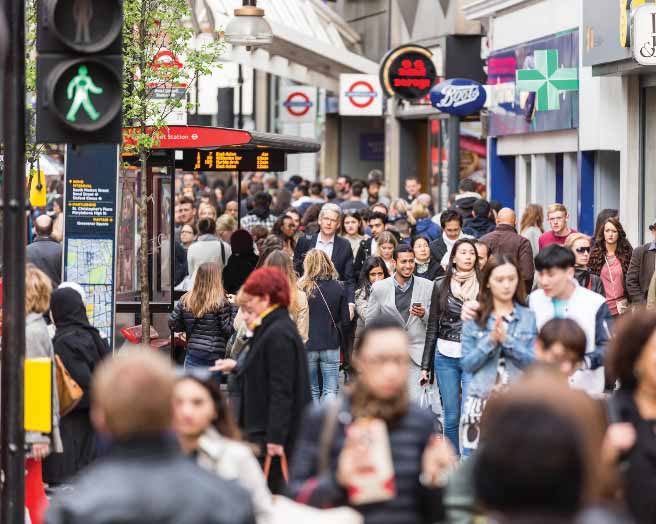The U.K. experienced an overall decrease in male suicide between 2016 and 2017; however, a longer-term trend of increasing rates of suicide among young people has emerged.
Learning this, I felt that the insurance industry should think about how we might help prevent suicides. The work Network Rail, the company in charge of Britain’s railway infrastructure, had done with Samaritans got me thinking. To me, Network Rail had a connection with suicides similar to that of the insurance industry: Rail workers are in a position to potentially spot someone who is suicidal and intervene, and the rail industry can also put proactive measures in place to aid in prevention.
Network Rail initiatives
“Brew Monday” was one such proactive measure. The campaign looked to turn Blue Monday, the third Monday in January (known to be the most depressing day of the year in the Northern Hemisphere), into Brew Monday. Tea bags handed out at railway stations encouraged people to “take time for a cuppa and a chat.” Many of Samaritans’ campaigns involve simple social interventions and checking on people.
Another Network Rail initiative placed Samaritans posters featuring a helpline number at the end of railway platforms. The company also trained staff to recognise the signs of someone who may be at a crisis point and how to intervene. To date, 19,000 frontline railway staff and personnel have been trained on how to intervene in suicide attempts, and in 2018-2019 the British Transport Police reported more than 2,000 life-saving interventions. Since these two initiatives have had such a big impact on saving lives on the railways, I wondered if the insurance industry could do something similar.
See also: Suicide and Claims Challenges
Insurance industry initiative
This led to a three-day design sprint in October 2018 with participants from across the industry, working together to consider the question: “How can insurers contribute to suicide prevention?”
Over the three days, we sought to understand as much as we could about suicide: who is affected, what they might be going through, what the insurance customer journey looks like, and what suicide prevention initiatives are working in other industries. The goal was to generate some practical ideas we could implement.
It quickly became apparent that the group had too many ideas to settle on one single solution in just three days. We therefore decided to keep the working group active for the next year at least and to work on approaches for implementing some of our ideas within the industry. The newly formed industry group, Action for Suicide Prevention in Insurance (ASPiiN), is made up of representatives from both insurers and reinsurers and meets monthly. Potential measures the group has proposed so far include:
Sympathy card
Bereavement that results from a loved one’s suicide can be incredibly difficult, and evidence suggests that this can even increase the risk of suicide among those affected. At the moment, when someone reports a death, a formal, computer-generated letter generally goes out to the claimant, advising them on next steps. The group thought a better practice would be to send a handwritten sympathy card, offering condolences and including information about how to seek help and self-care in addition to details on the claims process. This small but personal touch conveys the insurer’s genuine concern beyond simply executing a financial transaction.
After-claim care
Insurers can also do even more at claim stage to support the friends and family left behind by suicide. At the moment, insurers pay the claim and then play no further part in the support. The group suggested a phone call from the claims assessor to the claimant around three months after payment just to check whether they are getting all the emotional support they need. When the claim is being made, the claimant is likely to be in shock and functioning in autopilot mode, and it may not be until sometime later that the emotions hit them. That is why the timing of this follow-up from the claims assessor is important, as it gives the assessor the opportunity to recommend organizations the claimant could contact depending on the type of help they need, whether that’s advice on managing the estate, dealing with financial worries, or additional emotional support.
Google search recognition
If you type “suicide” in the Google search engine, the first thing that comes up is the Samaritans link and phone number. However, if you google a phrase such as “life insurance policy suicide definition,” no links to mental health-related sites appear. The results take you straight to the policy wording, which is likely to inform you there is only a first-year exclusion. If a customer is using these search terms, it likely means he or she needs help – and not in the form of a policy pay-out. The group is therefore working with Samaritans to make sure that Samaritans’ information comes up when someone is searching for their insurer’s suicide terms and conditions.
We are also looking at how a similar search and signposting process could be integrated into insurers’ own websites.
Claims staff to train as Samaritans volunteers
Since the purpose of the industry group is to contribute to suicide prevention, we wanted to encourage claims assessors and underwriters at each insurer to be trained as Samaritans (or any other suicide-related organization) volunteers. The skills they would learn for dealing with difficult calls could also benefit their work with customers completing claims or insurance applications.
All of these measures would be optional for the insurer and created with advice from experts.
See also: Suicide Trends and Risk Factors
Summary
Suicide is a serious challenge for society, and insurers have a unique opportunity to help develop solutions. Only six months after the design sprint and after only three meetings with the newly formed industry group, we have already started implementing some ideas we hope will contribute to suicide prevention.



